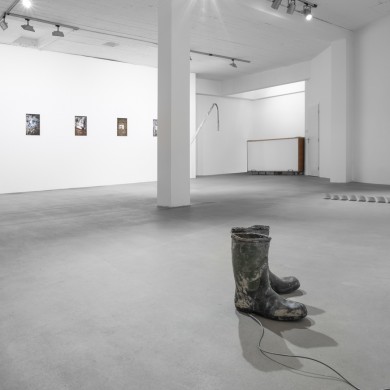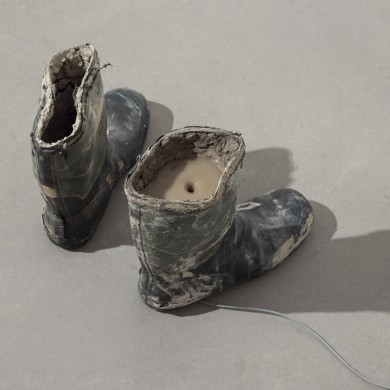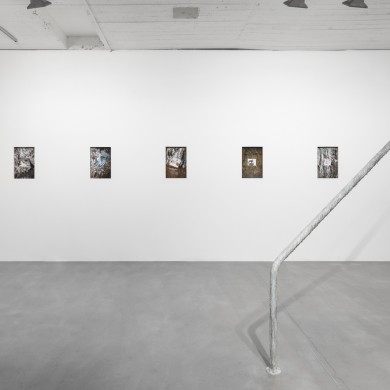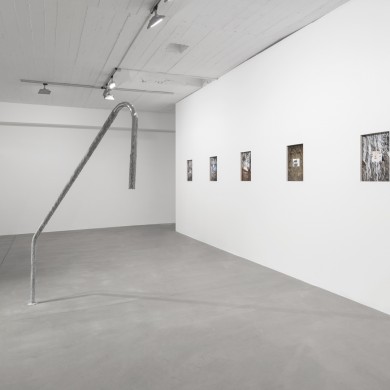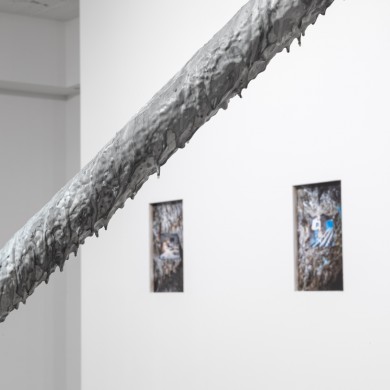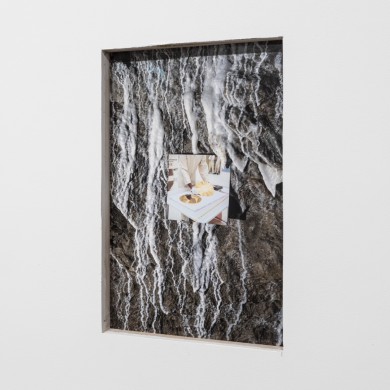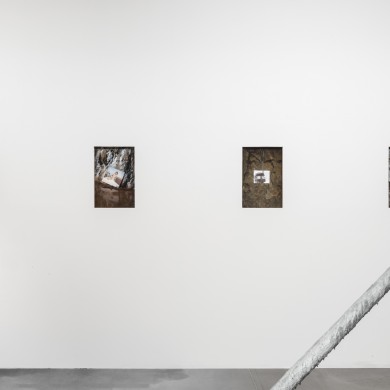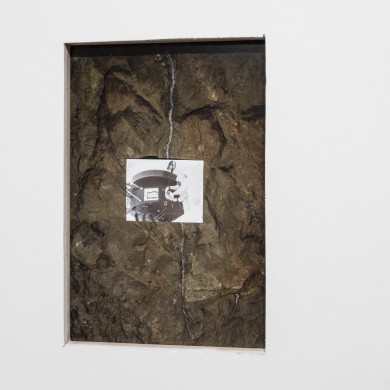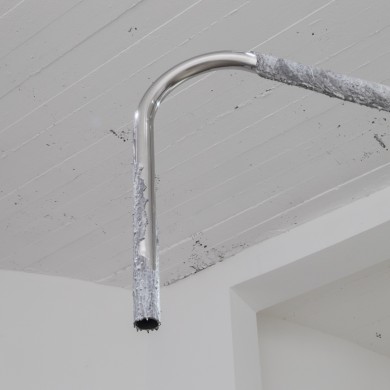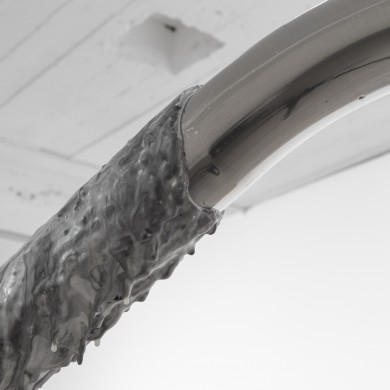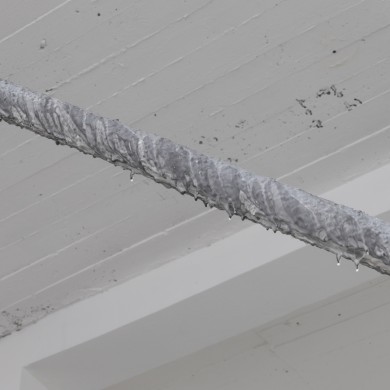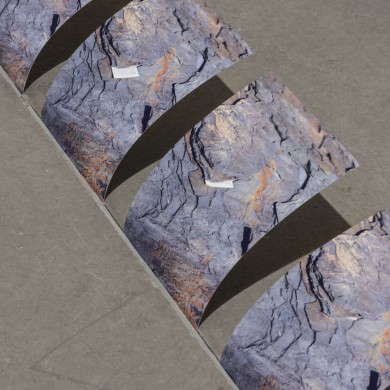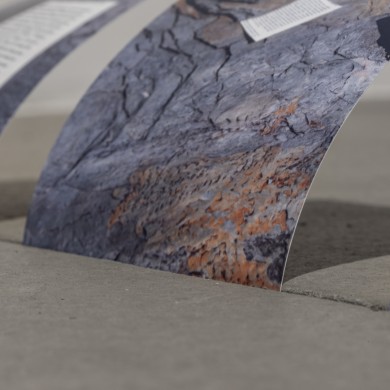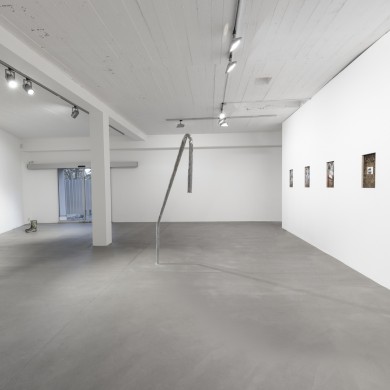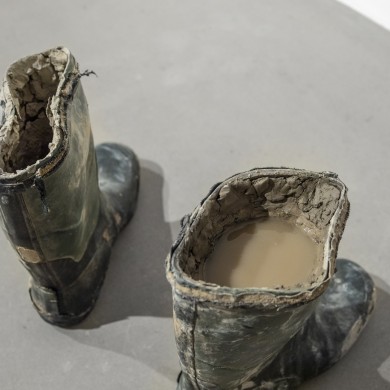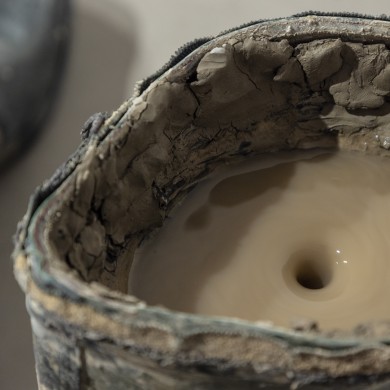Jaroslav Kyša
All Those Things We Never Thought Would End
Curator and text: Erik Vilím
4 Oct – 30 Nov 2022
ZAHORIAN & VAN ESPEN Bratislava
When Aristotle, writing in the distant past, proposed his definition of time, it was naturally a definition bound up with ourselves, the human beings. The principal motif was mutability: his time was played out in our sense experience, and its lead actor was change. This concept of time divided into past, present and future has formed European society, to the point where ultimately modern physics has explicitly opposed it. But did this time exist even before Aristotle? What about that strange time before thought described it, measured it, and establish basic categories for it? Who are its “pre-Aristotelian actors”: witnesses and writers of the story of the deeper history of Earth?
The time that was anchored before we imposed upon it our philosophical contours and mathematical equations, is paradoxically manifested to us most clearly in darkness, in the place that we tend to shy away from, perceiving it negatively: in the underground. Millions of years ago, it was none other than the underground that produced the original conditions for contemporary existence [ours included]. Deep below the surface, the earth’s tectonic layers carry records of the period when words such as past, present and future did not conceal reality. This time, of which we still know very little, is deep time, slow time, almost unobservable for human senses.
From the perspective of deep time, the human presence manifests itself as a brief flash: the grand history of conquest and subjugation of Nature is no more than the striking of a match. To contemplate this “littleness” of mankind is an act inseparable from humility. The geological layers beneath the surface are a register of contemporaneity in the bedrock of the Earth, while has still unexhausted possibilities of scientific reading. Among these “registers” are, for example, mines.
The mining culture that developed especially in the 18th and 19th centuries was a key player in western modernity: the great story of progress, which was launched by the industrial revolution. Natural minerals, heavy metals, and fossils lodged in the body of Gaia, are closely bound up with all that. Mines, as artificially created components of the world beneath the surface, have always been associated with something alien, just as caves had connotations of dirt and morality, as well as hard work. Ultimately, it is highly erroneous to see only “inorganic” Nature in them: mines that have lost any purpose for the human being live their own lives. From the standpoint of deep time, minerals and stones fold, stratify, and flow as lava. In abandoned mines they slowly take control, creating their own systems without human presence, and they write their small histories of Earth.
So then, who are these actors in the deep history of Earth? In Jaroslav Kyša’s solo exhibition All Those Things We Never Thought Would End they impress themselves on our thoughts like dumb narrators: a vortex in old potholers’ boots, a mine in Dobšiná transforming itself to a cave, the golden record on the Voyager spacecraft, and railings with artificially created accretions. Poetical, and at the same time sterile, they become virtual instruments for rethinking our relationship to the extra-human sphere and to a planetary history beyond the traditional anthropocentric perspective. This attempt to see the story of western modernity in a broader geological chronology follows on thematically from Kyša’s previous exhibitions (I Was Keeping It All Safe for You, Zahorian & Van Espen, 2019; Order of Waves, Synagogue – Centre of Contemporary Art, 2021, Breathe Deeper, Should You Need to Come Back, VUNU Gallery, 2022).
Jaroslav Kyša (*1981, Žilina) lives and works in Bratislava. He studied at the Free Creativity 3D Studio at the Faculty of Arts at the Technical University in Košice and the Spatial Communications + Studio at the Academy of Fine Arts and Design in Bratislava, where he currently works as an assistant at the Department of Intermedia. He has completed residencies in New York (ISCP, Brooklyn Langer Residency), Leipzig (Halle 14), and Slovenia (CELEIA). In 2011 he was a laureate of the Szpilman Award; in 2017 he won the NOVUM Foundation’s main prize, and he has twice been a finalist for the Oskár Čepan Award (2004, 2014). His works are part of collections in private hands, and also those of the East Slovak Gallery in Košice and The Museum of Art Žilina. The artist is represented by Zahorian & Van Espen Gallery.
Supported using public funding by Slovak Arts Council and nadácia mesta Bratislava.
Supported using public funding by Slovak Arts Council ![]()

Jaroslav Kyša
All Those Things We Never Thought Would End
Kurátor a text: Erik Vilím
4.10. – 30.11. 2022
ZAHORIAN & VAN ESPEN Bratislava
Keď v dávnej minulosti Aristoteles predložil svoju definíciu času, bola to, prirodzene, definícia zviazaná s nami – ľudskými bytosťami. Hlavným motívom bola premenlivosť – jeho čas sa odohrával v našej zmyslovej skúsenosti a jeho hlavným aktérom bola zmena. Tento koncept času rozdelený na minulosť, prítomnosť a budúcnosť formoval európsku spoločnosť, aby sa nakoniec do jeho opozície postavila moderná fyzika. Bol však tento čas aj pred Aristotelom? Čo s tým zvláštnym časom predtým, než ho myslenie popísalo, zmeralo a určilo mu základné kategórie? Kto sú jeho „pred-aristetolovskí aktéri“ – svedkovia a pisatelia dejín hlbšej histórie Zeme?
Čas ukotvený predtým, než sme mu vtlačili naše filozofické kontúry či matematické vzorce, sa nám ukazuje, paradoxne, najzreteľnejšie v tme, na mieste, od ktorého máme tendenciu sa odkláňať, vnímať ho negatívne – v podzemí. Pred miliónmi rokov to bolo práve podzemie, ktoré formovalo vznik podmienok pre [aj našu] súčasnú existenciu. Zemské tektonické vrstvy hlboko pod povrchom v sebe nesú záznamy období, kedy slová ako minulosť, prítomnosť a budúcnosť nepokrývali skutočnosť. Tento čas, o ktorom vieme stále len veľmi málo, je hlbokým časom, pomalým, pre ľudské zmysly takmer nepozorovateľným.
Z perspektívy hlbokého času sa ľudská prítomnosť ukazuje ako krátky záblesk – veľké dejiny dobývania a podriaďovania si prírody sú len škrtnutím zápalky. Nahliadnuť na túto „malosť“ ľudstva je akt spojený s pokornosťou. Geologické vrstvy pod povrchom sú záznamom súčasnosti v podloží Zeme, ktorý má stále nevyčerpané možnosti vedeckého čítania. Jednými z týchto „záznamov“ sú napríklad bane.
Banícka kultúra rozvíjajúca sa najmä v 18. a 19. storočí predstavovala kľúčového hráča západnej modernity – veľkého príbehu pokroku, ktorý akcelerovala priemyselná revolúcia. Prírodné minerály, ťažké kovy a fosílie uložené v tele Gaie sú s ním úzko previazané. Bane, ako umelo vytvorené súčasti sveta pod povrchom, boli vždy spájané s niečím cudzím, podobne ako jaskyne, asociovali špinu, smrteľnosť, ale aj ťažkú prácu. Je napokon veľmi mylné vidieť v nich len „neživú“ prírodu – bane, ktoré stratili pre človeka účel, žijú vlastným životom. Z pohľadu hlbokého času sa totiž minerály a kamene ohýbajú, vrstvia a tečú ako láva. V opustených baniach preberajú pomaly kontrolu, vytvárajú vlastné systémy bez prítomnosti človeka a píšu svoje malé histórie Zeme.
Kto sú to teda títo aktéri hlbokých dejín Zeme? Na sólovej výstave All Those Things We Never Thought Would End Jaroslava Kyšu sa ako nemí rozprávači vtláčajú do našich úvah vír v starých jaskyniarskych čižmách, baňa v Dobšinej transformujúca sa na jaskyňu, zlatá platňa na kozmickej lodi Voyager či zábradlie s umelo vytvorenými usadeninami. Poeticky a súčasne sterilne sa stávajú vizuálnymi nástrojmi ako nanovo premyslieť náš vzťah k mimo-ľudským sféram, k planetárnej histórií mimo tradičnú antropocentrickú perspektívu. Snaha vidieť príbeh západnej modernity v širšej geologickej chronológii tematicky nadväzuje na predošlé výstavné výstupy Kyšu (I Was Keeping It All Safe for You, Zahorian & Van Espen, 2019; Order of Waves, Synagóga – Centrum súčasného umenia, 2021, Breathe Deeper, Should You Need to Come Back, VUNU gallery, 2022).
Jaroslav Kyša (*1981, Žilina) žije a tvorí v Bratislave. Študoval v Ateliéri slobodnej kreativity 3D na Fakulte umení Technickej univerzity v Košiciach a v Ateliéri priestorových komunikácií + na Vysokej škole výtvarných umení v Bratislave, kde v súčasnosti pôsobí na Katedre intermédií ako asistent. Absolvoval rezidencie v New Yorku (ISCP, Brooklyn Langer Residency), Lipsku (Halle 14) či Slovinsku (CELEIA). V roku 2011 sa stal laureátom Szpilman Award, v roku 2017 vyhral hlavnú cenu Nadácie NOVUM a dvakrát bol finalistom Ceny Oskára Čepana (2004, 2014). Jeho diela sú súčasťou súkromných zbierok, zbierky Východoslovenskej galérie v Košiciach a Považskej galérie v Žiline. Autor je zastupovaný Zahorian & Van Espen Gallery.
